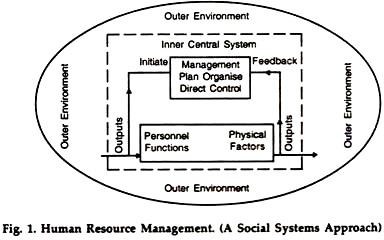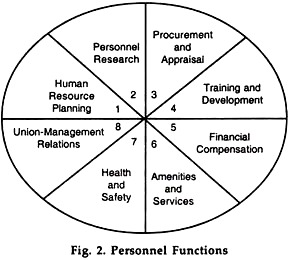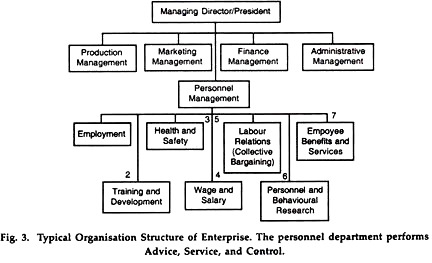Read this essay to learn about Human Resource Management. After reading this essay you will learn about: 1. Introduction to Human Resource Management 2. Systems Approach of Human Resource Management 3. Comments 4. Functions 5. Importance 6. Scope.
Contents:
- Introduction to Human Resource Management
- Systems Approach of Human Resource Management
- Comments on Human Resource Management
- Functions of Human Resource Management
- Importance of Human Resource Management
- Scope of Human Resource Management
Essay # 1. Introduction to Human Resource Management:
Human resource management (HRM), or human resource development, entails planning, implementing, and managing recruitment, as well as selection, training, career, and organizational development initiatives within an organization.
ADVERTISEMENTS:
The goal of HRM is to maximize the productivity of an organization by optimizing the effectiveness of its employees while simultaneously improving the work life of employees and treating employees as valuable resources. Consequently, HRM encompasses efforts to promote personal development, employee satisfaction, and compliance with employment-related laws.
To achieve equilibrium between employer and employee goals and needs, HRM departments focus on these three general functions or activities: planning, implementation, and evaluation.
The planning function refers to the development of human resource policies and regulations. Human resource managers attempt to determine future HRM activities and plan for the implementation of HRM procedures to help companies realize their goals.
Essay # 2. Systems Approach of Human Resource Management:
A system is an organised whole, consisting of interrelated and inter-dependent parts. A business enterprise is an open adaptive system describing the principal elements of the input transformation output system operating in its environment.
ADVERTISEMENTS:
Today management of personnel involves analysis of dynamic multiple and often conflicting forces. A badness enterprise is considered as a socio-economic system. It is part of a large system, namely, the. economic system. The economic system is again a pan of the political system of a country.
There are four components of a system:
1. Inputs,
ADVERTISEMENTS:
2. Processor,
3. Output,
4. Management as the regulator of the input, processor and output.
The following diagram describes these four basic components.
Members of the outer environment are owners, customers, labour organisations, rivals, suppliers, financial institutions, government and the public. All these parties have certain expectations from the business enterprise.
The society expects from the management of a business enterprise social responsible behaviour with employees, customers and the public. It also wants the business to maintain clean physical environment.
Human resource management is the sub-area of general management. It concentrates on the human activities element of general management. It is concerned primarily with manpower resource or inputs.
“Human resource management is the planning, organizing, directing and controlling of procurement, development, compensation, integration and maintenance of people for the purpose of contributing to organisation, individual and social goals.” Flippo, Principles of Human Resource Management.
ADVERTISEMENTS:
In a sense, management is personnel administration. Management is the development of people and not mere direction of material resources. Human capital is the greatest asset of a business enterprise. The essential ingredient of management is the leadership and direction of people.
Each manager of people has to be his own personnel man. Human recourse management is not something you really turn over to personnel department staff. A manager’s job at any level of hierarchy of an organisation is people and not production. He himself cannot produce. He get things done through the people.
The function of management is to manage:
1. Managers,
ADVERTISEMENTS:
2. Workers and
3. The work.
Management is keenly interested in the first two, i.e., in the optimum utilisation of human capital managers and workers. There is no universally accepted definition of human resource management. For our purpose, we would define human resource management thus:
Human resource management is the direction and co-ordination of Human Relations in the business organisation, thereby obtaining maximum production with minimum of physical and mental effort, stress and strain on the individual workers and groups of workers and without sacrificing the genuine well-being of the employees.
ADVERTISEMENTS:
The twin goals of productivity and satisfaction can be solved by enlightened personnel policies and programmes essentially through the process of integration, i.e., a reasonable reconciliation of individual, organisational and societal interests, procurement, development, maintenance and compensation of personnel are the normal functions.
But integration of different interests is the challenging task of human resource management.
However, under the systems approach, we visualize the business enterprise as a master system and also as a sub-system of its environment. Once we recognise the business as a socio-economic system, reconciliation of apparently conflicting interests of owners, employees, consumers, government and the society may not be a very difficult task.
Every business must justify its existence as a constituent of the society. It has to adapt and adjust continuously with the changing factors of its environment. We give in Fig. 2. the ingredients of personnel function.
The objective of human resource management is to attain maximum individual development, desirable work atmosphere and inter-personnel relations, and effective moulding of human resources as contrasted with physical resources.
ADVERTISEMENTS:
The essence of human resource management is the understanding of people at work (human factor in industry) and, on the basis of this knowledge, formulating personnel policies of the enterprise. The methods, tools and techniques designed to secure enthusiastic participation of labour constitute the subject matter of study in personnel administration.
Human Resource Department:
Human resource management is a staff function and the personnel department offers advice and service to all line executives on personnel matters. The Personnel Manager has ultimate responsibility for all personnel and labour policies.
A staff unit is expected to give advice, provide service, maintain control and perform administrative tasks. As an adviser, the personnel manager can screen and recommend the right person for the right job. In a service capacity, he supervises cafeteria, recreational programmes and offers counseling service to the employees.
As a control expert, he handles problems of wage and salary administration and as an administrator, he has to keep all personnel records, look after safety matters and problems of employee discipline. Fig. 3.gives the organisation chart of a personnel department.
Essay # 3. Comments on Human Resource Management:
1. Employment Section:
It is in charge of human resources planning, recruitment, selection, placement, induction, transfers and separation of employees. It keeps all employment records.
2. Training and Development:
It is in charge of planning and organising training programmes and activities relating to both operating staff as well as executive personnel (management development) and offering advice to management on promotion of deserving employees. It also looks after problems of retraining.
3. Health and Safety:
It looks after maintenance of employees’ physical and mental health and organises a sound safety programme which educates employees to act safely, conducts safety contests and enforces safety rules. There may be a safety engineer in charge of safety campaign in the plant.
ADVERTISEMENTS:
4. Wages and Salaries Administration:
It is responsible for job analysis, job evaluation, job classification, work standards, pay scales, incentive wages, bonus and fringe benefits. It evolves a sound plan of total compensation assuring equity and justice to all employees.
5. Labour Relations:
It negotiates collective bargaining contracts with union leaders and thereafter it has also to administer the labour-management agreement. In addition to this, it has to attend to grievances, receive suggestion plans, conduct morale surveys and ensure workers’ participation in management. The personnel manager has also to build up and maintain harmonious industrial relations.
6. Personnel Research:
The personnel manager must have an up to date research section to secure the latest information on any personnel problems and supply the same to concerned executives for solving those problems.
ADVERTISEMENTS:
Psychologist and sociologists are the specialists in conducting continuous research in human relations problems. It should be noted that human resource management is to a considerable extent applied industrial psychology. Research also is a means to bring about improved performance.
7. Employee Benefits and Services:
It manages to look after employee services, e.g., counseling, recreation, cafeteria, insurance, retirement, etc.
8. Organisation Development:
Under the systems approach, this is an additional function of human resource management since 1960.
Organisation development is a new field of activity under personnel. It has the following objectives:
ADVERTISEMENTS:
1. To manage change effectively,
2. To resolve conflicts,
3. To foster collaboration and team spirit among groups and individuals,
4. To emphasize accomplishment of organisation goals. Organisation development draws freely on the behavioural sciences dealing with organisational behaviour. It includes employee development and training.
9. Human. Resources Planning:
Another new function is that of planning human resources. It is a process to ensure that the right number of people possessing needed skills at the right time are available to perform the jobs.
Essay # 4. Functions of Human Resource Management:
The personnel manager has to perform the managerial, functions such as planning, organising, (directing, motivating and controlling personnel working in his department. In addition to the usual managerial functions mentioned above, he has also operative functions in the personnel field covering the entire enterprise.
The operative functions are:
1. Procurement,
2. Development,
3. Compensation,
4. Integration and
5. Maintenance.
1. Procurement:
It covers human resource planning and forecasting and the process of recruitment, selection, placement and induction of newly appointed employees.
2. Development:
Development of workers and managers demands systematic programmes for employee training and management development. Programmes of performance appraisal, promotion, transfer, etc., are also included under this function. Development function yields synergic effect, viz., 2+2 = 5
3. Compensation:
Equitable remuneration in the form of wages, salaries, bonuses assume great significance as compensation is the main motivator because our wants are satisfied with the help of money in the “market for goods and services. Economic compensation involves varied and complex problems. It governs labour management relations.
4. Integration:
Individual, social and organisational goals and interest are diverse and conflicting. They have to be reconciled and properly co-ordinated or integrated. Then only employees can offer their willing co-operating for united and joint enterprise. Democratic management reduces conflicts and assures effective morale and motivation. We also need best communication, meaningful, interesting and challenging jobs.
5. Maintenance:
It covers personnel activities relating to employee health and safety, favourable work environment, employee benefits and services, labour welfare work, worker participation in management, etc. The hygienic or maintenance factors of Herbert are duly recognised under this function.
Foundation of Sound Human Management Programme:
1. Adequate and fair earnings of employees.
2. Job security, job enrichment, and job enlargement.
3. Favourable Work environment.
4. Social security and labour welfare.
5. Sound promotion policy providing ample scope for self-advancement.
6. Effective labour participation in management to create sense of belonging.
7. Wage incentives- and profit-sharing plans.
8. Better employee communication.
9. Standing organisation for settlement of employee grievances.
10. Congenial supervisory climate.
11. Democratic and participative leadership.
12. Proper financial and non-financial motivation.
13. Scientific selection and training of workers and wise management development programme.
14. Collective bargaining with strong trade union or labour organisation.
If enlightened and forward looking management provides the positive and concrete measures mentioned above, we can eliminate labour unrest, strikes, lockouts and geherao, etc., and management through its personnel manager can succeed in preventing strikes and lockouts and naturally ensure best industrial relations which alone can provide maximum productivity and prosperity to be shared equitable by all the interested parties, viz., owners, employees, consumers, etc.
Employee Wants:
Among the commonly mentioned employee wants in business organisations are the following:
1. Pay,
2. Security of job,
3. Congenial associates,
4. Credit for work done, i.e., appreciation, recognition,
5. A meaningful job e.g., through job enlargement,
6. Opportunity to advance, i.e., promotion prospects,
7. Comfortable, safe and attractive working conditions,
8. Competent and fair leadership and
9. Participation in Management.
If these wants are reasonably satisfied, we can have cordial labour-management relations and naturally higher productivity and profitability. Human resource management tries to satisfy these employee wants. In short, enlightened human resource management alone can solve the problem of manpower management and ensure a high employee morale.
Implementation of HRM plans involves four primary activities: acquisition, development, compensation, and maintenance. Acquisition entails the hiring of workers most likely to help a company attain its goals. The development function encompasses the training of workers to perform their tasks in accordance with company strategy.
This activity also involves company efforts to control and change employee behavior via reviews, appraisals, incentives, and discipline. Compensation covers the payment of employees for their services.
Maintenance requires structuring labour relations the interaction between a company’s management and its unionized employees and ensuring compliance with federal and state employment laws. Finally, the evaluation function includes the assessment of a company’s HRM policies to determine whether they are effective.
Different terms are used to denote human resource management. They are: labour management, labour administration, labour-management relations, employee-employer relations, industrial relations, personnel administration, human resource management, human capital management, human asset management, human resources management and the like.
Though these terms can be differentiated widely, the basic nature of distinction lies in the scope or coverage and evolutionary stage. In simple sense, human resources management means employing people, developing their resources, utilizing, maintaining and compensating their services in tune with the job and organizational requirements.
Essay # 5. Importance of Human Resource Management:
Human resource management is also a management function concerned with hiring, motivating, and maintaining people in an organisation. It focuses on people in organisations. Simply put, Human Resource Management (HRM) is a management function that helps managers recruit, select, train and develop members for an organisation. Obviously, HRM is concerned with the people’s dimension in organisations.
Specifically, the following constitute the core of HRM:
1. Organisations are not mere bricks, mortar, machineries or inventories. They are people. It is the people who staff and manage organisations.
2. HRM involves the application of management functions and principles. The functions and principles are applied to acquisitioning, developing, maintaining, and remunerating employees in organisations.
3. Decisions relating to employees must be integrated. Decisions on different aspects of employees must be consistent with other human resource (HR) decisions.
4. Decisions made must influence the effectiveness of an organisation. Effectiveness of an organization must result in betterment of services to customers in the form of high-quality products supplied at reasonable costs.
5. HRM functions are not confined to business establishments only. They are applicable to non-business organisations, too, such as education, health care, recreation, and the like.
Obviously, HRM refers to a set of programmes, functions and activities designed and carried out in order to maximise both employee as well as organisational effectiveness.
Essay # 6. Scope of Human Resource Management:
The scope of HRM is indeed vast. All major activities in the working life of a worker from the time of his or her entry into an organisation until he or she leaves come under the purview of HRM.
Specifically, the activities included are-HR planning, job analysis and design, recruitment and selection, orientation and placement, training and development, performance appraisal and job evaluation, employee and executive remuneration, motivation and communication, welfare, safety and health, industrial relations (IR) and the like.
For the sake of convenience, we can categories all these functions into seven sections:
(i) Introduction to HRM
(ii) Employee hiring
(iii) Employee and executive remuneration
(iv) Employee motivation
(v) Employee maintenance
(vi) IR
(vii) Prospects of HRM
The primary objective of HRM is to ensure the availability of a competent and willing workforce to an organisation. Beyond this, there are other objectives, too. Specifically, HRM objectives are four fold societal, organisational, functional and personal.
Societal Objectives to be ethically and socially responsible to the needs and challenges of the society while minimising the negative impact of such demands upon the organisation. The failure of organisations to use their resources for the society’s benefit in ethical ways may lead to restrictions.
For example, the society may limit HR decisions through laws that enforce reservation in hiring and laws that address discrimination, safety or other such areas of societal concern.
Organisational Objectives to recognise the role of HRM in bringing about organisational effectiveness. HRM is not an end in itself. It is only a means to assist the organisation with its primary objectives. Simply stated, the department exists to serve the rest of the organisation.
Functional Objectives to maintain the department’s contribution at a level appropriate to the organisation’s needs. Resources are wasted when HRM is either more or less sophisticated to suit the organisation’s demands. The department’s level of service must be tailored to fit the organisation it serves.
Personal Objectives to assist employees in achieving their personal goals, at least insofar as these goals enhance the individual’s contribution to the organisation. Personal objectives of employees must be met if workers are to be maintained, retained and motivated. Otherwise, employee performance and satisfaction may decline and employees may leave the organisation.


